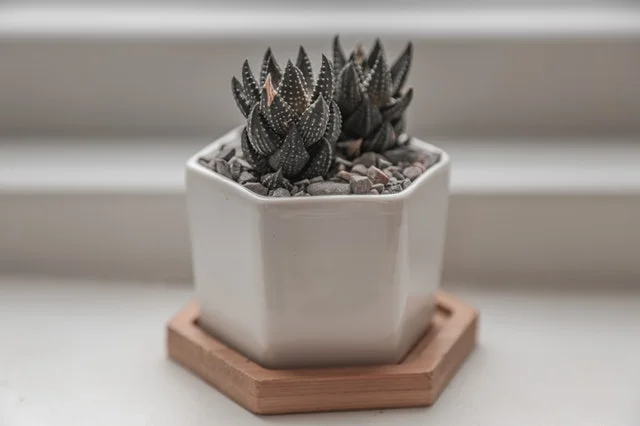The haworthiopsis attenuata is also known as the zebra haworthia. The nickname comes from its pattern of dark green and lighter colors on the leaves, along with the textured ridges.
The small species of succulent plant is from South Africa, more specifically the Eastern Cape Province.
This particular species is attractive with its rosette shape and is often used as a decorative houseplant. It is one of the most commonly grown kinds of haworthiopsis plant.
The zebra haworthia is slow-growing and rarely blooms when grown indoors. When the blooming does occur, it is typically during the summer. The flowers are usually pink or white and have a tubular shape.
Table of Contents
How To Care For Haworthiopsis Attenuata
With the best care, while being slow-growers at first, the plants can produce offsets and pups quickly once they are established in life.
Providing care for these succulents can be easy as they only need the basics and are highly tolerant of varying conditions.
What does your haworthiopsis attenuata require?
While these succulents can perform well, both indoors and outdoors, most of these care requirements pertain to house plants.
Providing these basics is essential to the overall health of the haworthiopsis attenuata.
- Light Requirements: The plants grow better in bright filtered light. They can tolerate lower levels of lighting for longer periods than other succulents. This factor is perhaps one reason why they are such popular houseplants. However, when bright light is available, it should be placed near it to make up for the time without it. Obtaining between four and six hours of bright, filtered light each day is optimal. In cases when this lighting is not available, a sunlamp can help.
- Temperature Requirements: The best temperatures range between 18-26 degrees Celsius (65-80 degrees Fahrenheit). Haworthiopsis attenuata plants can tolerate lower temperatures of between -1 to 10 degrees Celsius (30-50 degrees Fahrenheit) if necessary. To maintain a healthier plant, it should not be kept in colder temperatures for extended periods.
- Humidity Requirements: This species does not require humidity. Ventilated air is necessary, but this can be achieved through a fan if necessary. Air circulation is more important at night because it needs carbon monoxide for photosynthesis.
- Water Requirements: These plants require watering about every seven to ten days in the warmer months and approximately once a month during the winter. You can add plenty of water to moisten the potting mix, but then it is not needed again until the soil is dry. Care should be taken so that water does not collect in the rosette.
- Soil Requirements: The most suitable potting mixes are well-draining with a neutral to acidic pH. Products specifically designed for succulents are recommended.
- Fertilizer Requirements: Small amounts of diluted fertilizer may be added to the soil between spring and autumn. Plant food is not needed during the winter.
Extra Tips For Haworthiopsis Attenuata
The succulents can tolerate many kinds of environments, and only need simple care to survive and thrive. However, it can be convenient to know what types of issues could arise and why.
Health problems are very few, as are infestations, although some may be considered more common than others. Of course, it may be helpful to know how to prune and propagate the plants too.
Pests and Diseases
There are three main issues that the haworthiopsis attenuata species might combat during its life.
Each one, in most cases, may be prevented by not overwatering the soil. Too much moisture is often the cause of the following infestations and the appearance of fungus.
- Scale Insects: These oval/round pests get their name because several of the insects in one area of the plant resemble scales. Individually, they may simply look like bumps on a leaf or stem. Scale insects can be killed by dabbing them with rubbing alcohol. However, an easier method of eliminating infestations is by removing the entire leaf that is affected.
- Mealybugs: This type of insect has a white or light pink segmented body. It leaves a white dusty-like substance on leaves and stems. These, like scale insects, can be killed instantly by dabbing with rubbing alcohol. Insecticides can be applied to destroy infestations. Damaged leaves and stems must be removed.
- Root Rot: This is a fungal disease that starts at the root and creeps up the stems and leaves. It causes discoloration, turning leaves yellow or brown. It can also cause the stems to go soft. The best remedy is removing the damaged areas and repotting the plant in a fresh potting mix in a new pot with fungicide.
Pruning
Pruning can be done by cutting off the leaves with a sterilized sharp knife. The cuts should not be made using scissors because they can damage the flesh.
If you are removing damaged areas that impact the health of the plant, it can be done as soon as possible.
However, for trimming back the plant, giving it more vitality, or obtaining cuttings for other reasons, the pruning should be done in early spring just before the new growth begins.
Flowering haworthiopsis attenuata plants can be trimmed in winter while they are dormant or just after they bloom.
Propagation
The simplest methods used to propagate haworthiopsis attenuata succulents are through leaf cuttings and offsets. The leaf cuttings may be taken the same way as the pruning. The cutting should be left to dry before planting in the potting mix.
Offsets can be removed from the mother plant using a sharp sterile knife. Extra caution should be used so that the plant and its roots are not damaged.
The offset can be planted in a small pot with the same kind of potting mixture as used by the mother.
Repotting
Repotting may be needed several times for these plants. Eventually, the mother, as well as the pups and offsets, tend to outgrow their original pots.
If you prefer not to repot the original plant, and the mother has not outgrown the container, pruning and removing offsets can help to increase the amount of space available. However, at some point, the mother plant may still need repotting.
Toxicity
Haworthiopsis attenuata are usually non-toxic to people and animals.
Photo by Talal Hakim from Pexels



